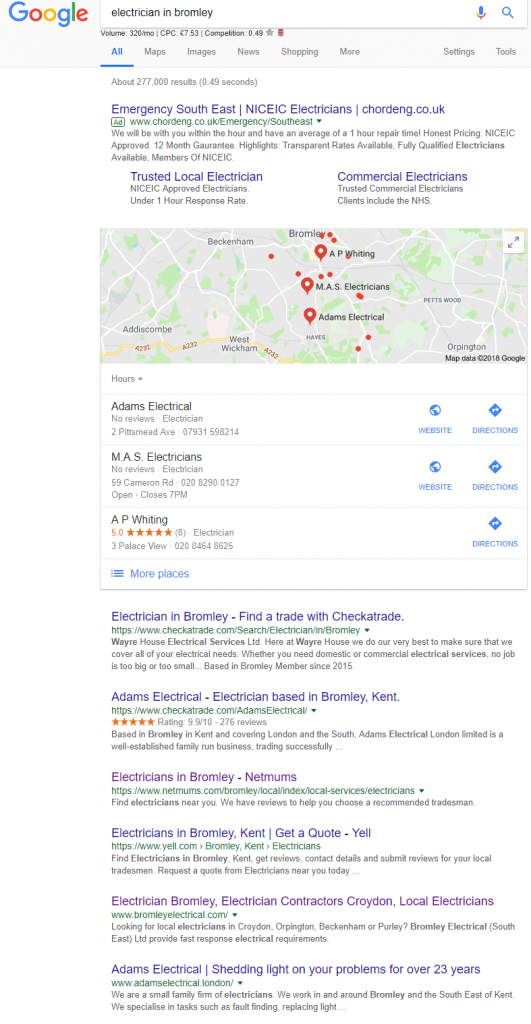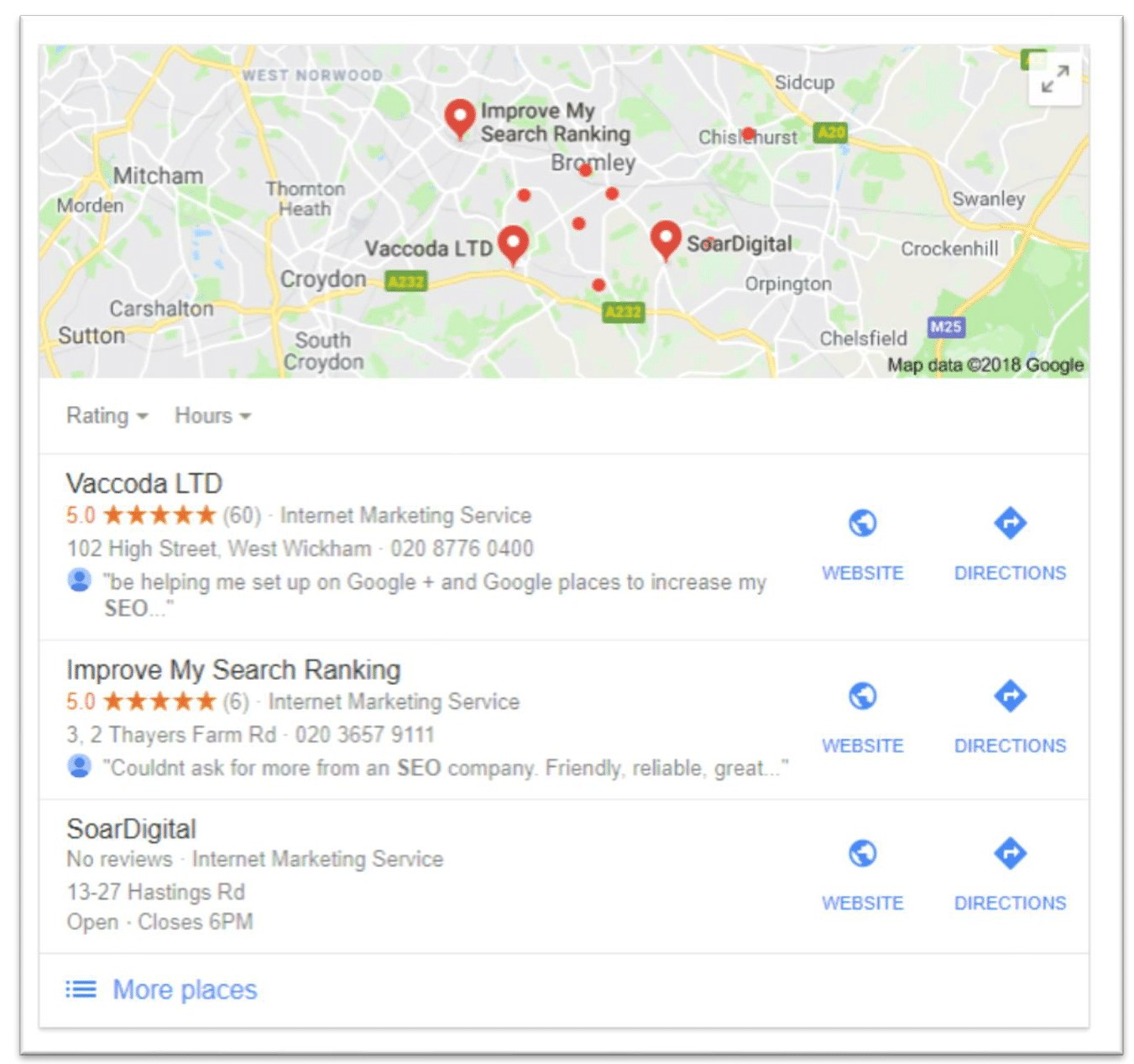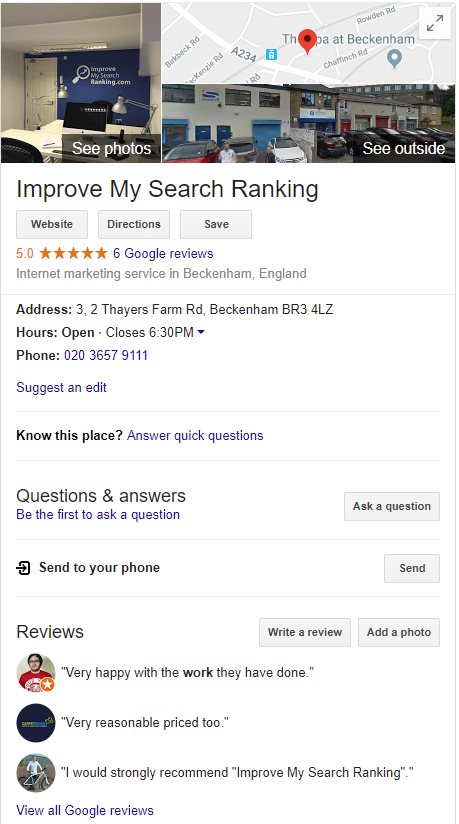
SEO For Plumbers – How To Get Number #1 in Google | IMSR
SEO For Plumbers
This new guide will show you everything you need to know about SEO for plumbers and how you can get your plumbing business to the top of Google.
First, I’ll show you why this is more important than ever.
Then, I’ll help you get your website correctly optimised so you shoot to the top of Google and get more customers.
Sound Good? Let’s dive right in…
___________________________________________________________________________
Contents
- Why Do I Need SEO?
- Step 1: Keywords
- Step 2: Technical Optimisations
- Step 3: Google My Business
- Step 4: Social Media
- Step 5: Backlinks
___________________________________________________________________________
Why do I need SEO?
How SEO can help your plumbing business
In this chapter, I’ll help you get the basics down.
You’ll get an understanding of what our SEO for plumbers guide is about and how it can help grow your business.
Then, we will get onto our 5-step process where you’ll learn our proven strategies and techniques to achieving SEO success.
Reason 1: Statistics Don’t Lie…
Be honest, what is the first thing you do when you’re looking for a local service? I’m betting you jump on Google and type in what you are looking for followed by your area. It probably looks something like this:
‘Electrician in Hertfordshire’ | ‘Carpet Cleaner in Bromley’ | ‘Locksmith in Chelsea’
Then what do you do? You probably ignore the advertisements and click on the best-looking website from the top three results and make a phone call.
Well guess what… You’re not alone:
- 93% of all ONLINE EXPERIENCES begin with a search engine.
- 75% users NEVER SCROLL to Page 2.
- 70 – 80% users IGNORE THE PAID ads and focus on organic search results.
If your still not convinced, here’s a few more statistics:
- In 2017, the average company allocated 45% of their marketing budget to their SEO efforts.
- 40% of mobile searches are for a local service.
- SEO is the number 1 driver of traffic, beating social media by over 300%.
Pretty impressive right?
___________________________________________________________________________
Reason 2: SEO Allows You to Dominate Other Areas…
The problem with directories is you’ll only be displayed for searches local to your headquarters.
This is an issue if – let’s say – you’re based in one town but you also service other towns or areas further away from you. Any potential customer from another area, searching for your service, will only get a result from a company closer to them than you are based.
In steps SEO…
With SEO you can overcome this issue and dominate any town, county or area you want to.
Let’s look at an example…
Your business might be based in ‘Croydon’ but you service up to a 10-mile surrounding area. With SEO you can appear top for searches made for ‘Plumbers in Bromley’, ‘Plumbers in Beckenham’, ‘Plumbers in London’.
This means you can dominate all the local areas and have way more customers.
___________________________________________________________________________
Reason number 3: SEO is an investment and long-term strategy…
So why should you bother with SEO when you can use pay-per-click and get a top spot instantly?
Well – for starters, pay-per-click can be very expensive meaning your return on investment is a lot lower than SEO. Also, a recent survey reported that 91% of consumers said they preferred natural search results whilst looking for a service online.
Oh, and don’t forget – when you stop paying for pay-per-click you’ll vanish into the depths of page 2 and beyond…
SEO – however – is a different ball game.
There’s no hiding that SEO takes a lot more initial work. But, if done correctly – you’ll reap the long-lasting rewards. You’ll have a much higher click through rate, have a much higher return on investment and your site will stay in the top positions for a while even after you quit your SEO efforts.
So, without further ado – let’s dive into how you can get your plumbing business to the top of Google in 5 proven steps…
___________________________________________________________________________
Step 1: Keyword Research
“He who fails to plan is planning to fail” – Winston Churchill
The first step to any successful SEO strategy is to research what keywords you are going to rank for.
Wait. What is a keyword?
A keyword is a technical term for a phrase someone might type into Google. For example, ‘Plumber in London’ or ‘Plumber in Yorkshire’. Each keyword will return a different set of results. I’m betting you typed in something like ‘seo for plumbers’ or ‘plumbers seo guide’.
What we want to find out is what keywords are best for us to rank for and which are going to bring in the most customers.
Luckily, there are tools which we can use to enable us to see how many people are looking for each keyword phrase. I recommend using one of these FREE following tools:
- Google Keyword Planner – learn more here.
- Moz’s Keyword Explorer – learn more here.
- Keywords Everywhere Plugin – learn more here.
For the sake of this guide, I am using the Keywords Everywhere Plugin.
Once you have picked your tool, the first thing we do is type in our main keyword phrase. This should be ‘Plumber in’ (followed by your local town).
It should look something like this:
The bit we are interested in is ‘volume’.
As you can see, the volume for my keyword is 480. This means there are 480 searches per-month for this particular keyword. This is a good volume.
I suggest finding a volume in the region of 10 – 1,000 searches per month. Anything less than that and it is not worth ranking for and anything more than that and it will be too competitive.
If your nearest town does not have a big enough search volume then I suggest you try a bigger local town or your overall county/area until you find something more fitting.
Once you have found a good keyword to rank for then we can move onto the next step!
Let’s go!…
___________________________________________________________________________
Step 2: Technical Optimisations
Setting Your Site Up For SEO Success
Technical optimisations… sounds scary! Don’t’ worry, it’s not all that difficult.
Now that we know our main keyword phrase, the first thing we want to do is stick it into the following places on your homepage:
- The Title Tag
- The Meta Description
Both of these are what we see when Google returns a result. The title tag is simply the title and the meta description is the little description underneath (see example below).
In order to do this, I recommended downloading Yoast SEO Plugin which makes it nice and simple. Read more about how to do this here.
Once you have done this it should look something like the following (notice the keywords are in bold):
Once the above two have been completed then the next things to do is set up both a HTML and XML sitemap.
Both of these are lists of pages which Google uses to index your website better.
An XML sitemap will be automatically installed once you install Yoast and a HTML sitemap can be set up by adding a new page to your site and then adding the following plugin: HTML Page Sitemap.
The next thing to do is set up a privacy policy page – you can get more advice on this by clicking here. Google likes to know your following privacy laws.
It is also important to have your physical address in the footer of your website. So, make sure you put this in here.
Now we’re getting somewhere!
So, the next optimisation we want to do is to optimise our image alt-tags. Google doesn’t see an image like we do – it just see’s a long string of code. So, we need to describe to it exactly what the content of our image is.
To do this we find the image in the media gallery and insert a relevant description under ‘alt-text’. Simple right?
And finally, the last important technical optimisation you need to make is to litter your keyword throughout your content on your homepage.
What I mean by this is you need to drop your keyword into the text on your homepage a few times. Also make sure you are using variations of your keyword. For example, ‘Bromley plumbing services’ – ‘Bromley plumber’ – ‘plumber based in Bromley’.
Whilst we are on the subject of content, it is also important that the text on your website is at least 500 words. Google favours content, so the more content you have the better you will rank. As long as the content is good quality, of course!
If you have followed all of this then great! Let’s get cracking with the next step.
___________________________________________________________________________
Step 3: Google my Business
Managing Your Online Presence
Setting up a Google My Business is easy and should only take a matter of 5 minutes.
This is important for showing up in the ‘map-pack’ part of Google which looks like this:
If you have already set up a Google-My-Business page then you can skip this step and go straight to step 4 – check you out!
If you haven’t already created a Google My Business page – here’s how you do it:
- Go to the following link: https://www.google.co.uk/intl/en/business/
- Click: ‘Start Now’.
- Follow the onscreen instructions.
- You will be sent a verification code via the post in 3 – 4 days.
- Once you have got this code, verify your page and your good to go.
That’s it. Your all set up and ready to go.
Just a couple of pointers though:
Make sure that you include a good business description, lots of photos of your work and logo, all the relevant business information and try to get as many reviews as possible on your page.
This all increases the chances of your page being displayed higher in Google and the likability of someone going to click through to your website.
A well set up page should look like this:
Sorted? Cool! Let’s move on.
___________________________________________________________________________
Step 4: Social Media
Spread The Word About How Great Your Business Is
Social media and SEO go hand-in-hand.
It is important to have a good social media strategy to build your overall brand and increase your organic rankings.
So, what social media channels do you need to have?
The following are important to set up and link to your website:
- YouTube
- Google-plus
You also need to have a link to your social channels from your website.
Once you have all these channels set up then you need to start being active on them.
In a perfect world, you would be posting on all of these channels at least once a day.
However, in reality this is probably not going to happen. So, I recommend just focusing on posting to Facebook, Twitter and Google-plus at-least 3 times per week.
As well as posting regularly, you need to also focus growing your followers. Google isn’t stupid though, so don’t go and buy fake followers!
Well there you have it, another simple but effective step in getting your website to the top of Google. Onto step 5 of this seo for plumbers guide!
___________________________________________________________________________
Step 5: Backlinks & Citations
Making Your Website A Power House
Perhaps one of the most important steps in boosting your site to the top of Google is having a good backlink and citation strategy.
Wait… a what?
Right, let me break it down nice and simple for you…
A citation is a mention of your business information on a directory across the web. This is important as the more places you a mentioned, the more Google recognises you as a proper business and will increase your rankings.
I recommend getting your business featured on (at-least) the following sites:
- Yell.com
- Netmums
- net
- Yelp
- Scoot
- Free Index
- Hot Frog
To see more, see this article here…
There are a couple of tips for this strategy too…
Firstly, make sure you keep all of your information the same across all of your directory listings. Next, make sure you always add a link back to your website (most people forget to do this). Lastly, try to add images if the directory allows you – this makes you look a lot more professional.
The next part of this step is backlinks.
A backlink is similar to a citation; however, it is a mention on somebody else’s website rather than a directory. Whether that is a blog, a news website or any other website that will provide a link back to your website.
This is very important because Google will see this link to your website and think “oh, they have a link from (…) this must mean they are a good site”. The more links you have, the more Google trusts your site and the higher you will rank.
So, how do you get these backlinks exactly?
It’s called the magic of a blog. A blog is a very important asset to many businesses. In fact, ‘81% of businesses regard their blog as an important asset to their business’.
But what would I write about?
Write about what you know… plumbing.
Write guides, tips and tricks, latest industry news, diy advice – etc…
Keep it short and sweet (around 500 – 1000 words will do) and post regularly.
If your interesting, people will start linking to your articles naturally – which is great!
If your struggling for links, then reach out to other bloggers in the industry and ask them what they think about your most recent article.
They are likely to give you a mention on their blog.
To find these bloggers just type in:
‘plumbing bloggers’ | ‘diy bloggers’ | ‘construction bloggers’
Or anything else you think is relevant.
Here’s a few to get your started:
As I said, this is a very important aspect of your SEO strategy and you should work on this every month.
___________________________________________________________________________
Summary
SEO For Plumbers In A Nutshell
Well, there you have it.
A complete 5-step guide on how to get your plumbing business to the top of Google to get more business.
Remember, the main points we covered are:
- Do your keyword research – location(s) + plumbers.
- Technical optimisations: title tag, meta descriptions, heading structure, sitemaps, image alt-tags & good quality content.
- Set up a Google My Business page – get reviews, images and correct information on there.
- Set yourself a good social media strategy and have all the channels set up and branded to your business.
- Start getting backlinks and building citations (getting your business featured on directories or other’s blogs).
And the best part? These techniques can be applied to a range of industries. Are you an electrician? Wedding planner? Cake maker? Do you run a shop or cake decorating school? Whatever your niche, try our tips and your see results.
I hope you found this – plumbers seo guide – useful. If you have any questions then please feel free to get in touch or leave a comment and I’ll help you out.
Many thanks,
Ryan.
Resources:
<div>Icons made by <a href=”http://www.freepik.com” title=”Freepik”>Freepik</a> from <a href=”https://www.flaticon.com/” title=”Flaticon”>www.flaticon.com</a> is licensed by <a href=”http://creativecommons.org/licenses/by/3.0/” title=”Creative Commons BY 3.0″ target=”_blank”>CC 3.0 BY</a></div>
<div>Icons made by <a href=”https://www.flaticon.com/authors/roundicons” title=”Roundicons”>Roundicons</a> from <a href=”https://www.flaticon.com/” title=”Flaticon”>www.flaticon.com</a> is licensed by <a href=”http://creativecommons.org/licenses/by/3.0/” title=”Creative Commons BY 3.0″ target=”_blank”>CC 3.0 BY</a></div>
<div>Icons made by <a href=”https://www.flaticon.com/authors/pixel-perfect” title=”Pixel perfect”>Pixel perfect</a> from <a href=”https://www.flaticon.com/” title=”Flaticon”>www.flaticon.com</a> is licensed by <a href=”http://creativecommons.org/licenses/by/3.0/” title=”Creative Commons BY 3.0″ target=”_blank”>CC 3.0 BY</a></div>
<div>Icons made by <a href=”https://www.flaticon.com/authors/prosymbols” title=”Prosymbols”>Prosymbols</a> from <a href=”https://www.flaticon.com/” title=”Flaticon”>www.flaticon.com</a> is licensed by <a href=”http://creativecommons.org/licenses/by/3.0/” title=”Creative Commons BY 3.0″ target=”_blank”>CC 3.0 BY</a></div>
<div>Icons made by <a href=”https://www.flaticon.com/authors/prosymbols” title=”Prosymbols”>Prosymbols</a> from <a href=”https://www.flaticon.com/” title=”Flaticon”>www.flaticon.com</a> is licensed by <a href=”http://creativecommons.org/licenses/by/3.0/” title=”Creative Commons BY 3.0″ target=”_blank”>CC 3.0 BY</a></div>
<div>Icons made by <a href=”https://www.flaticon.com/authors/prosymbols” title=”Prosymbols”>Prosymbols</a> from <a href=”https://www.flaticon.com/” title=”Flaticon”>www.flaticon.com</a> is licensed by <a href=”http://creativecommons.org/licenses/by/3.0/” title=”Creative Commons BY 3.0″ target=”_blank”>CC 3.0 BY</a></div>
<div>Icons made by <a href=”https://www.flaticon.com/authors/smashicons” title=”Smashicons”>Smashicons</a> from <a href=”https://www.flaticon.com/” title=”Flaticon”>www.flaticon.com</a> is licensed by <a href=”http://creativecommons.org/licenses/by/3.0/” title=”Creative Commons BY 3.0″ target=”_blank”>CC 3.0 BY</a></div>
<div>Icons made by <a href=”https://www.flaticon.com/authors/alfredo-hernandez” title=”Alfredo Hernandez”>Alfredo Hernandez</a> from <a href=”https://www.flaticon.com/” title=”Flaticon”>www.flaticon.com</a> is licensed by <a href=”http://creativecommons.org/licenses/by/3.0/” title=”Creative Commons BY 3.0″ target=”_blank”>CC 3.0 BY</a></div>
<div>Icons made by <a href=”https://www.flaticon.com/authors/photo3idea-studio” title=”photo3idea_studio”>photo3idea_studio</a> from <a href=”https://www.flaticon.com/” title=”Flaticon”>www.flaticon.com</a> is licensed by <a href=”http://creativecommons.org/licenses/by/3.0/” title=”Creative Commons BY 3.0″ target=”_blank”>CC 3.0 BY</a></div>




















